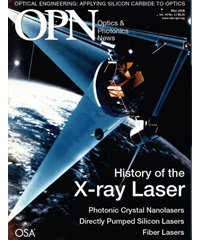
May 2008 Issue
Feature Articles
Directly Pumped Silicon Lasers
Over the past two decades, researchers have tried mightily to enhance silicon’s ability to emit light. Yet electrically pumped silicon lasers remain tantalizingly out of reach. These authors describe how the approaches that have been tried so far might be successfully combined.
by Jeffrey M. Shainline and Jimmy XuElectrically Pumped Photonic Crystal Nanolasers
For years, the quantum optics community has been testing the limits on laser size: How small can you go? Thanks to advances in semiconductor crystal growth and fabrication techniques, the answer is now wavelength-scale.
by Hong-Gyu Park, Min-Kyo Seo, Se-Heon Kim and Yong-Hee LeeFiber Lasers and Their Coherent Beam Combination
With high efficiency and exceptional beam quality, fiber lasers hold great promise. The 1-µm wavelength makes it possible for them to replace both diode- and lamp-pumped Nd:YAG lasers in the micromachining, automotive and biomedical markets.
by Qihong Lou, Jun Zhou, Bing He and Hongming ZhaoThe History of the X-ray Laser
The long and curious history of the X-ray laser began in an effort to expand the frontier of knowledge and culminated in one of the wildest schemes ever pursued by the United States government—the “Star Wars” missile defense initiative in the 1980s.
by Jeff HechtDepartments and Columns
Problem-Based Learning
A new educational project encourages students to learn optics by tackling real-world technical and engineering challenges.
Applying Silicon Carbide to Optics
Silicon carbide (SiC) is a promising optical material that offers several performance advantages over traditional optics. Due to its unique physical and thermal properties, it can be used for a wide range of applications—from large space-based telescope systems to small galvo mirrors.
Science and Policy: Not Mutually Exclusive
As scientists work in labs across the United States, policymakers pass laws, rules and regulations in the chambers of the U.S. Capitol. For many people, these two worlds seem completely separate. The truth is, science and policy are not mutually exclusive; in fact, they are heavily dependent on each other.
Micro-harp Resonates to Sound Out Gases
Researchers at the Naval Research Laboratory have made a “micro-harp” that operates on a scale about a thousand times smaller than the normal instrument, with “strings” that are roughly 200 µm in length.
Honorary Members of the 1950s
From its beginnings in 1916, the Optical Society has dedicated a special category of membership to individuals who have made unique, unparalleled contributions to the field of optics. This column highlights the careers of four optical pioneers who became honorary members during the 1950s: Frits Zernike (1954), Charles Edward Kenneth Mees (1957), Thomas Smith (1957) and William F. Meggers (1958).
Whose Law of Refraction?
The law of refraction is one of the most fundamental and important principles in optical science. After years of conflict over who discovered it first—Snel, Hariot or Descartes—some Arab scholars have now brought the 10th-century scientist Ibn Sahl into the fray. Here, Gorden Videen ponders the question: Can’t we all just get along?
OPN Talks with David Reitze
Our conversation with David Reitze, LIGO expert and CLEO/QELS plenary speaker.
Imaging Collagen Fibers
A group of researchers has used intense X-rays to achieve unprecedented resolution of the structure of the protein collagen.
Did You Know?
A quantum stroboscope.
OPN Talks with Albert Polman
Our conversation with Albert Polman, nanophotonics expert and CLEO/QELS plenary speaker.
ADVERTISEMENT
ADVERTISEMENT
Also in this Issue
Book Reviews
In Memory
Remembering James J. Snyder and Joseph LeFevre Horner.

![Illustration of optical skyrmions. [Y. Shen]](https://opnmedia.blob.core.windows.net/$web/opn/media/images/articles/2025/0525/departments/202505-cover-web.jpg?ext=.jpg)
![Illustration of a synapse in the brain. [Getty Images]](https://opnmedia.blob.core.windows.net/$web/opn/media/images/articles/2025/0425/departments/202504-cover-web.jpg?ext=.jpg)
![Fiber draped around a hand, demonstrating its flexibility. [Photo by Z. Wang and L. Wei]](https://opnmedia.blob.core.windows.net/$web/opn/media/images/articles/2025/0325/departments/202503-cover-web.jpg?ext=.jpg)